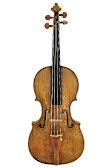Jacob Stainer
around 1618 to 1683As the relevant baptismal register from Stainer’s birthplace, Absam, has not survived, the exact date of his birth could not be ascertained. One of his letters implies that he was born around the year 1618. While no records of his apprenticeship have been found, stylistic similarities indicate that Nicolò Amati may have been his teacher. Stainer is likely to have stayed in Salzburg and Munich in 1644, as job orders from the respective courts document. Whereas Stainer returned to Absam in 1645 and founded a family, historical records show that he probably also stayed in other towns for longer periods in the following years. In 1646, he traveled to Venice, and one year later, he stayed in Kirchdorf in Upper Austria. By this time, his reputation had spread beyond his hometown. After 1648, orders came in from cities like Bolzano and Brixen. The Innsbruck court was also among his customers, and in 1658, Archduke Ferdinand Karl awarded Stainer the title “servant of the Archduke.” This honorary title did not afford Stainer a position at court, but it did raise his social status. Stainer was well-read, and traveling broadened his mind. He had become familiar with the concepts of the Reformation, no small danger in staunchly Catholic Tyrol. As a search of Stainer’s house had turned up books on the Index of Forbidden Books, the city priest of Hall denounced Stainer as a heretic in 1668. As a result, a consistory (i.e. ecclesiastical) court in Brixen investigated this very serious charge against Stainer for over a year. Despite using clever delaying tactics and exhausting all legal remedies, Stainer could not escape a conviction, but at least he succeeded in staving off excommunication. During this period of personal setbacks, Stainer’s reputation had reached its zenith, as the slew of job orders from neighboring countries demonstrates. His productivity was impressive, especially considering that he never had an apprentice or assistant. The final years of Stainer’s life were marked by illness. A 1680 entry in an accounting ledger of the Elector states that Stainer had become “quite senseless.” He could still work during this last period of his life, albeit probably with interruptions.
Stainer’s violins typically feature high arching and an excellent acoustic quality. Until the late 18th century, they were thus highly sought after and were also the most expensive string instruments next to those of Nicolò Amati. When large concert halls and symphonic orchestras became standard from the 19th century, soloists preferred instruments by Stradivari and Guarneri that had in the meantime been modified with longer necks and that were considered more attractive for their somewhat greater carrying power.

